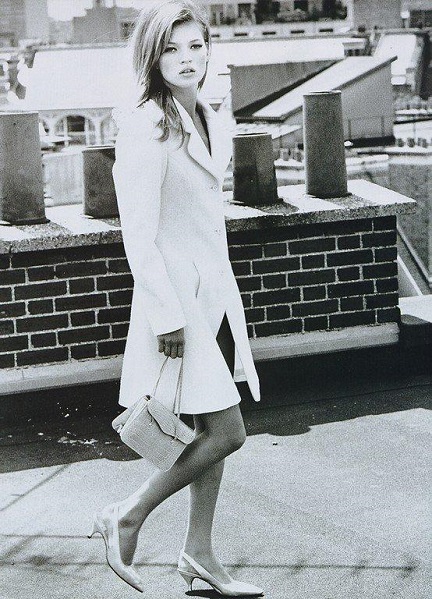Heroin Chic — Not Just About Fashion.

{source}
The moral implications of a discussion detailing a drug, so potent, and with a certain stigma attached to it, runs the risk of being misinterpreted. The gravity of the message may be overlooked, and its intended meaning may be distorted.
Heroin has been derided and viewed with much contempt, ever since it gained greater acceptance and subsequent infamy within the framework of the social construct termed popular culture, which we feed and feed off.
Heroin has been a source of refuge to some in the pursuit of artistic and philosophical ideals; it has also led to the destruction and slow decay of many others. The ethicality of its use is therefore subjective. A comparison may be drawn here to the equally controversial nature of the command yielded by popular culture.
Popular culture is both formless and tangible. It has unprecedented reach and sway over those of us who uphold the Western, or to be more specific, the North American, curriculum of entertainment. To conceive of our nature and being, minus this powerful element, is an exercise that is futile and will leave us perplexed.
It leaves us wondering if we are even capable of aligning ourselves with an alternate entertainment and sociocultural benchmark.
Stripped of our conscious choices in music, literature, television, technology and clothing, invariably dictated by what is referred to as Americana, where would we stand? Who would we be? It is something we should apportion some thought to.
Have we been reduced to junkies incapable of aesthetic and intellectual stimulation, without the American brand of culture and entertainment?
The subconscious acceptance of this standard has led to us longing for its product; it is the same one that instills within us the calculated and harmful concepts of beauty that are paraded deliberately before our eyes.
What follows is an examination of the human psyche, as much as it is a foray into the perverse means by which we measure success and beauty.
We are exponents of collectivism for the most part, though individualistic trends have crept into our habits, gradually. We tend to absorb both the positive and negative strands of collectivist culture, and conformance is one of its components.
The truth of the matter is that the human mind is vulnerable and lacks a clear and strict pattern of operation; we derive meaning, sometimes where there is none, from the external stimuli we are exposed to. It is in our nature to follow and imitate what is known to be safe and popular.
Even the free spirits and misfits among us conform to a certain norm, even if it is not the one adhered to by the majority. An ascetic too conforms to a set of beliefs discerned to be noble and purer by him, regardless of his existence beyond the periphery.
The inference here may be one that involves semantics, but it is unquestionable that we do conform.
It is this tendency that is preyed on by fashion powerhouses and those who have much to gain from our entertainment-related choices. Through the subtle manipulation of certain shortcomings and retarded inclinations within us, it is possible to get us to identify with trends that would otherwise seem inefficient and lacking purpose.
As humans, could the general malaise surrounding our existence have resulted in a state so deceptive, that it rendered us capable of glorifying heroin and the appearance associated with its use, merely to sell clothes and a particular look?
I speak of the Heroin chic movement, which was a manifestation of the abnormal innovations of the fashion industry we have been subjected to periodically, and of the incongruous behavioral patterns we display. The Heroin chic movement adopted the waifish structure and look.
It is easily recognizable due to the scrawniness and homeless nature associated with the look.
The departure from the norm was advocated in the mid-1990s by fashion mogul Calvin Klein, in retaliation to thehealthy and vibrant look that had thrived until then.
They strategically decided to feature Kate Moss in their advertising campaigns, revealing a demeanor and body structure starkly different from the stereotype considered beautiful at the time.
Although I was exposed to it once the movement had subsided, I was immediately drawn to the term Heroin chic and the associated look. An unusual connection was formed, and I could identify with why it was thought to be beautiful and contemporary (at the time), in a most androgynous and ambiguous manner.
Despite this affinity, I was able to engage in the rational thought process necessary to comprehend the basic elements of this phenomenon. It led me to propose several possible social and psychological effects.
Firstly, it must be said that the utilization of abstract and unapparent influences in the development of an art form are to be encouraged, celebrated even. But when it departs so drastically from the prejudices and beliefs we hold, we are relegated to beings that are unable to produce consistent thought patterns.
While we are so consumed as a culture in abhorring and condemning the use of heroin and other drugs, we have failed to address the circumstances which might have led its users to resort to such a misunderstood panacea.
What could have resulted in a trend so atypical that we felt it alright to conceive a fashion movement capitalizing on a distinct look, marked by freakishly pale skin, clearly discernible eye sockets, angular bone structure and pronounced dark circles underneath the eyes?
The promotion of such features would seem reprehensible in most contexts, yet the vision persisted for a while.
Therein, a mismatch of human principle is existent.
The second concern leads once again to the topic of conformance, and how it may result in unhealthy and counterproductive practices, in an objective sense. Such a dramatic shift in the perception of beauty and the acceptance of new ideals in relation to attractiveness can often be misleading and lead to insecurity and compound self-esteem issues.
The practical ramifications of the Heroin chic movement, and similar developments thereafter, were vast, and culminated in models pursuing the accepted standard, the subsequent consequences of which were bulimia, anorexia, depression, and more fatally, suicide.
Once models at the helm falter under the weight of the fashion industry, through the lure of contracts, advertisements and sponsorship fees, the corporations can usually get them to bend to their will and determine what is beautiful in a particular season and what ought to be trendy.
A certain look will be established, and those occupying the rungs below will purposefully emulate and crumble. The socialites will follow suit thereafter. The rest will engage their efforts in the scramble towards the attainment of the desired look.
While this is expected and can be accepted in the case of conformance leading to a healthy transformation, in the event of an innovation such as Heroin chic, it leaves a lot to be desired.
The human mind is a wondrous realm, predisposed to an utter lack of predictability, in spite of our biases and moral limits. We are capable of learning, adapting, adopting and unlearning. As such, the logical reaction to the constituents of popular culture that bind us should be one that is measured.
Also, a degree of caution should be displayed prior to accepting all that is presented by the fashion industry at face value.
This is but an opinion piece and an analysis replete with human tendencies and subjective interpretations.
Perhaps the answers sought through the course of this discussion have been found now.
We remain unpredictable — and are not fixed in our ways — though we conform.
*****
Gavinda Jayasinghe is an independent writer and singer-songwriter. He is of the view that both these forms of expression segue into each other unobtrusively. It is his purpose to instill in himself and promote among others, through the aforementioned vehicles, virtues such as compassion and equality. He commenced his tertiary education in Perth, Australia and completed his Bachelor’s degree in Missouri, USA. He can be contacted via email or Facebook.


